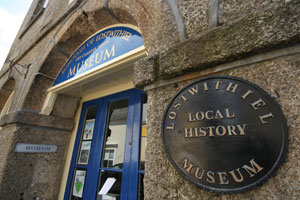
16 Fore Street,
Lostwithiel, PL22 0BW
Tel: (01208) 873593
Email: info@lostwithielmuseum.org
Web: www.lostwithielmuseum.org
History of a town
Go back seven centuries and Lostwithiel was Cornwall's capital and a port of national importance, exporting tin, wool and hides. Nearby Restormel Castle was the Black Prince's county seat from 1358. Three centuries on, the ruins of the Duchy Palace are mute testimony to the enduring importance of the town in the Civil War.
There are other, less stark signs of Lostwithiel's place and purpose in history: the dedication of the old church to St. Bartholomew, the patron saint of tanners; the old Tudor bridge built to take the wagons across the Fowey; lovely old Taprell House and the fine Guildhall, built in 1740 and now home to a museum which pulls together all the threads of war and peace.
The museum is housed in a Georgian building on Fore Street. It was originally the Corn Exchange and has also been a school-room, a butchers, then a magistrate's court and the town jail. Nowadays the building houses the Guildhall, which is used for meetings of Lostwithiel Town Council, above the museum. On the 21st August 1971 Lostwithiel Museum was opened by the Earl & Countess Mount Edgcumbe whose ancestors had rebuilt the premises in 1740.
Rare photographs capture the changes in the town and its people from the earliest days of the camera. There are displays of agricultural and domestic implements alongside textiles, minerals, weapons and artefacts from Lostwithiel's chequered past.
The largest and most dramatic display is the town's original hand-pumped, 18th century fire engine, the most poignant, the Town Sergeant's cloak, riddled with bullet-holes. All human life is here, from a long period in Cornish history when it was short and hard, but never dull.
At the top end of Fore Street, below the main road.
Opening TimesOpen Monday to Friday, Admission Free |
Fowey Lostwithiel Restormel Castle St. Austell Duchy Palace